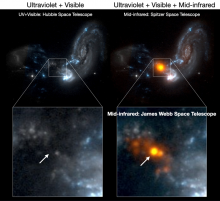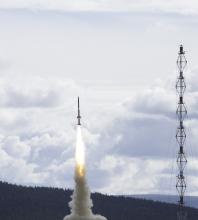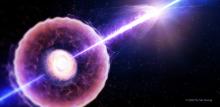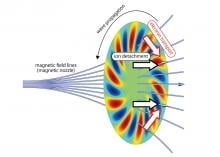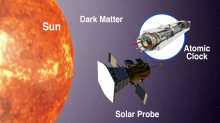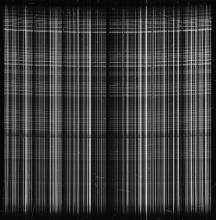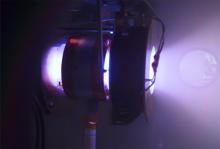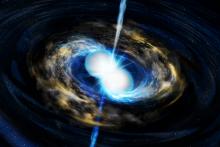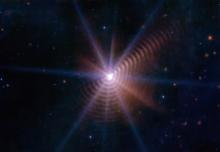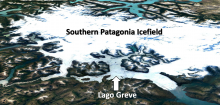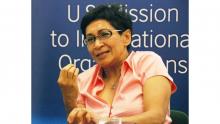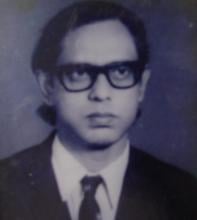Space
News
01 Mar 2023
An international research team has discovered the first example of a supernova, known as SN 2018ivc, showing an unprecedented rebrightening at millimeter wavelengths about one year after the explosion.
With the help of the Atacama Large Millimeter/submillimeter Array -- or ALMA -- the analysis revealed that the dying massive star ejected a large amount of its envelope due to a strong binary interaction with a companion star that took place about 1500 years before the explosion.
In a paper published in The Astrophysical Journal Letters, the team posits that this rebrightening event in SN 2018ivc provides a missing link between supernovae -- or SN -- that occur in binary star systems and those that involve solitary massive stars.
28 Feb 2023
Researchers at Tohoku University have analyzed samples from asteroid Ryugu. They identified some of the oldest solids from the solar system to date, and their findings suggest that the asteroid initially formed in the outer reaches of the solar system.
28 Feb 2023
Osaka Metropolitan University scientists identified about 140,000 molecular clouds in the Milky Way Galaxy from large-scale data of carbon monoxide molecules, observed in detail by the Nobeyama 45-m radio telescope. Using artificial intelligence, the researchers estimated the distance of each of these molecular clouds to determine their size and mass, successfully mapping the distribution of the molecular clouds in the Galaxy in the most detailed manner to date.
17 Feb 2023
Tree rings forecast extreme weather in central Asia, Squid 🦑and chemistry make versatile hydrogels, James Webb telescope reveals the earliest galaxies & Reducing negative effects of screen time. Read all in the latest Editor's Choice. Plus our latest journalist resource "Experts for Media: Antimicrobial Resistance "🦠.
03 Feb 2023
Researchers used the James Webb Space Telescope to identify the precise location of a powerful energy source hidden by cosmic dust in the luminous merging galaxy IIZw096.
20 Jan 2023
Overeating mechanism: why "eating just one chip"🍟 is impossible, Measuring hidden energy of gamma-ray bursts, Marine species that can adapt to ocean acidification & A rough start can lead to a strong bond, Read all in our first Editor's Choice of 2023. Plus our interview on what dengue vaccine approval in EU💉means for global dengue protection.
13 Jan 2023
Understanding how dust grains form in interstellar gas could offer significant insights to astronomers and help materials scientists develop useful nanoparticles.
13 Jan 2023
A team including Kavli IPMU has studied the relation between galaxy size and luminosity of some of the earliest galaxies in the universe taken by the James Webb Space Telescope, less than a billion years after the Big Bang.
06 Jan 2023
Asia Research News monitors the latest research news in Asia. Some highlights that caught our attention this week are how mysterious enormous space bubbles are formed, how drinking sweet drinks might contribute to hair loss, and a synthetic tissue created to give pigs back their erectile function.
19 Dec 2022
When stars die out, they emit gamma-ray bursts. Although scientist can calculate the explosion energy from dying stars, it is difficult to do when the conversion efficiency is low or unknown. Using light polarization, a research group has found a workaround for this, enabling astronomers to calculate the hidden energy of gamma-ray bursts.
16 Dec 2022
Asia Research News monitors the latest research news in Asia. Some highlights that caught our attention this week are how we determine which animals we would eat or not, a robot with sticky magnetic feet that can climb, and coriander seeds that had a great holiday in space.
07 Dec 2022
Magnetic nozzle plasma thrusters are thought of as the future of space travel. But one problem has hampered their development – plasma detachment. A recent study has shown that spontaneously excited plasma waves help magnetic nozzles overcome the plasma detachment problem, a rare instance of plasma instabilities having a positive effect on engineering.
05 Dec 2022
Studying an atomic clock on-board a spacecraft inside the orbit of Mercury and very near to the Sun could be the trick to uncovering the nature of dark matter.
25 Nov 2022
Asia Research News monitors the latest research news in Asia. Some highlights that caught our attention this week are a new planet that orbits a dying star, a map of all the airborne microbes, and the potential to protect our organs by hibernating during surgery.
18 Nov 2022
Exploring virtual human-agent relationships, A fly protein gives clue for human cancers, Rare earth elements formed in neutron star mergers 💥, One-stop process for hydrogen production. Read all in the November's Editor's Choice plus Upcoming event K4DM KNOWLEDGE MARKETPLACE – Bangkok 2022: Exchanging Ideas for a Democratic Myanmar.
14 Nov 2022
Muon non-destructive analysis of Asteroid Ryugu revealed the raw materials of solid matter at the outer regions of the early solar system. The samples contain less oxygen relative to silicon than typical CI chondrites, indicating that previous CI chondrite samples may have been contaminated by terrestrial materials, thus redefining the standard elemental composition of solid materials in the solar system.
11 Nov 2022
The international collaboration developing the Prime Focus Spectrograph (PFS), which includes Kavli IPMU and more than 20 collaborating institutions, has marked a significant testing milestone by successfully taking spectra of targeted stars.
11 Nov 2022
Space missions already use electric propulsion devices, where electromagnetic fields are utilized to generate the thrust of spacecraft. One such electrodeless device, which harnesses radio frequency (rf) to generate plasma and a magnetic nozzle (MN) to channel and accelerate plasma, has shown immense promise in pushing the boundaries of space travel. But scientists have so far failed to achieve efficient conversion of the rf power to thrust energy. Now, a Tohoku University researcher has achieved a 30% conversion efficiency, the biggest rate to date.
28 Oct 2022
Asia Research News monitors the latest research news in Asia. Some highlights that caught our attention this week are a toothpaste that can be used in space, how to always win at a quantum game, and a trunk-inspired robot gripper.
27 Oct 2022
When two neutron stars merge, the resultant explosion forms heavy elements—many of which make up our Universe. A new study has, for the first time, identified the specific rare-earth elements produced in a neutron star merger.
25 Oct 2022
Small neighboring galaxy filled with dark matter detected with gamma rays, How a virus induces heart inflammation, Shedding light on the happy hormone, Microfossils may hold key evolution clues. Read all in the October's Editor's Choice plus Upcoming event KNOWLEDGE MARKETPLACE – Bangkok 2022: Exchanging of ideas for a Democratic Myanmar.
21 Oct 2022
Asia Research News monitors the latest research news in Asia. Some highlights that caught our attention this week are scaling up production of a zombie fungus, the critical eye of female dogs, and enlightenment available on your smartphone.
13 Oct 2022
Puzzling image from the James Webb Space Telescope explained in two new studies
06 Oct 2022
Asia Research News monitors the latest research news in Asia. Some highlights that caught our attention this week are what happens when the sun goes to sleep, creating a silk stronger than a spider, and a robot that can laugh with you.
04 Oct 2022
Only satellites were watching when the world's fourth-largest proglacial lake suddenly drained in 2020. Hokkaido University researchers now uncovered the event and analysed the cause—the collapse of a sediment bump at the outlet of the lake.
03 Oct 2022
Supermassive black holes can launch fast-moving plasma, which emit strong radio signals known as radio jets. Despite being discovered over 40 years ago, much remains unknown about how radio jets are produced. Now, a research team, led by Tohoku University astrophysicists, has attempted to clarify how plasma gets loaded into radio jets.
23 Sep 2022
A team of researchers have analyzed the elemental composition of asteroid Ryugu using an artificially generated muon beam from a particle accelerator.
21 Sep 2022
Giants in History: Malaysia’s first astrophysicist, Mazlan binti Othman (born 11 December 1951) was instrumental in launching the country’s first microsatellite, and in sending Malaysia’s first astronaut, Sheikh Muszaphar Shukor, into space.
06 Sep 2022
Researchers have used giant lobes of gamma radiation to find that a small satellite galaxy of the Milky Way filled with dark matter, but whose emissions are more likely the result of millisecond pulsars blasting out cosmic particles.
29 Aug 2022
Researchers at Osaka Metropolitan University have observed "baby stars" in the Small Magellanic Cloud, having an environment similar to the early universe. Toward one of the baby stars, they found molecular outflow, which has similar properties to those seen in the Milky Way galaxy, giving a new perspective on the birth of stars.
Events
Sorry, no events coming up for this topic.
Researchers
Sorry, no researchers coming up for this topic.
Giants in history
Chinese electron microscopy specialist Li Fanghua (6 January 1932 – 24 January 2020) facilitated the high-resolution imaging of crystal structures by eliminating interference.
Haisako Koyama (1916 – 1997) was a Japanese solar observer whose dedication to recording sunspots – cooler parts of the sun’s surface that appear dark – produced a sunspot record of historic importance.
Angelita Castro Kelly (1942-2015) was the first female Mission Operations Manager (MOM) of NASA. She spearheaded and supervised the Earth Observing System missions during its developmental stage.
Malaysia’s first astrophysicist, Mazlan binti Othman (born 11 December 1951) was instrumental in launching the country’s first microsatellite, and in sending Malaysia’s first astronaut, Sheikh Muszaphar Shukor, into space.
Meghnad Saha (6 October 1893 – 16 February 1956) was an Indian astrophysicist best known for formulating the Saha ionization equation which describes the chemical and physical properties of stars.
Subrahmanyan Chandrasekhar (19 October 1910 – 21 August 1995) was an Indian astrophysicist who studied the structure and evolution of stars.
Abdus Suttar Khan (c. 1941 – 31 January 2008) was a Bangladeshi engineer who spent a significant part of his career conducting aerospace research with NASA, United Technology and Alstom.
Bibha Chowdhuri (1913 – 2 June 1991) was an Indian physicist who researched on particle physics and cosmic rays. In 1936, she was the only female to complete a M.Sc. degree at the University of Calcutta.





